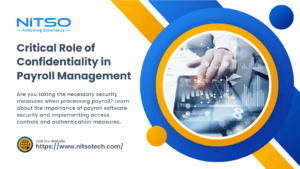Payroll management is a critical aspect of any organization’s operations. Payroll is the process of calculating and disbursing employee salaries and benefits. The accuracy of payroll management is essential to maintain employee satisfaction, comply with legal requirements, and avoid financial penalties. Inaccurate payroll can lead to costly errors, disputes with employees, and legal liabilities. Therefore, ensuring that the payroll management process is accurate and efficient is crucial.
This article will explore the importance of payroll management accuracy, the steps to ensure it, and the key performance indicators (KPIs) to measure accuracy.
Table of Contents
What is Payroll Management Accuracy?
Payroll management accuracy refers to precision and correctness in the processes and systems used to manage employee compensation and benefits. It involves ensuring that all payroll calculations, deductions, and taxes are accurately calculated and processed and that employees are paid the correct amount of compensation on time.
Inaccurate payroll management can have severe consequences for both employees and the company. Employees may not receive the correct amount of pay or benefits, leading to dissatisfaction and potential legal issues. The company may also face compliance issues and penalties from regulatory bodies if payroll calculations and tax deductions are incorrect.
Therefore, achieving payroll management accuracy is critical for employees and the company. This requires a thorough understanding of relevant labour laws and regulations, accurate tracking of employee attendance and time worked, automated payroll systems and regular audits and reviews to identify and correct errors in payroll records. Visit if you want to know about 7 Common Payroll Management Errors and Tips to Avoid Them.
Key Requirements of Payroll Management Accuracy
Payroll management accuracy is critical for ensuring that employees receive the right amount of compensation on time and that the company remains compliant with relevant regulations. Several key requirements must be met to achieve accuracy in payroll management.
- Proper Employee Classification: One of the most critical aspects of payroll management accuracy is ensuring that employees are classified correctly. This involves ensuring that employees are classified as either exempt or non-exempt according to relevant regulations and that they are classified according to their job duties and responsibilities.
- Accurate Timekeeping: Another important aspect of payroll management accuracy is ensuring that timekeeping is accurate. This means ensuring that employees are accurately tracking their time worked and that supervisors are accurately tracking employee attendance and absences.
- Compliance with Labour Laws: In order to achieve payroll management accuracy, it is essential to remain compliant with all relevant labour laws. This includes ensuring that employees are paid at least the minimum wage, that overtime is paid when required, and that all payroll taxes and other deductions are appropriately calculated and remitted.
- Use of Automated Payroll Systems: Automated payroll systems can help to ensure payroll management accuracy by automating many of the calculations and processes involved in payroll management. This helps reduce errors and ensure that all calculations are accurate and up-to-date.
- Regular Audits and Reviews: Regular audits and reviews can help to ensure payroll management accuracy by identifying any errors or discrepancies in payroll records. This helps ensure that errors are corrected in a timely manner and that all records are up-to-date and accurate.
Best Practices for Ensuring Payroll Management Accuracy
1. Use Automated Payroll Systems
Automated payroll systems can help eliminate errors and increase efficiency. These systems can automatically calculate employee wages, taxes, and deductions and generate reports for payroll processing. They can also provide accurate data for tax filing and compliance purposes.
2. Maintain Accurate Employee Records
Accurate employee records are crucial for payroll management accuracy. This includes maintaining up-to-date information on employee personal information, payroll deductions, tax withholdings, and benefits. By keeping accurate records, you can ensure that employees are paid correctly and avoid legal penalties.
3. Verify Data and Check for Errors
It’s crucial to verify employee data before processing payroll to ensure accuracy. This includes checking employee hours, wage rates, and deductions. You should also check for any errors that may have occurred during the data entry process.
4. Conduct Regular Audits and Reconciliations
Regular audits and reconciliations can help identify errors and discrepancies in payroll processing. These audits can help ensure that employee hours and wages are accurately recorded and that taxes and deductions are correctly calculated.
5. Create a Backup Plan for Processing Payroll
It’s essential to have a backup plan for processing payroll in case of an unexpected event, such as a power outage or system failure. This can help ensure that payroll is processed on time and accurately.
6. Implement Time Tracking for Hourly Employees
Time tracking systems help ensure that hourly employees are accurately paid for their time worked. These systems can track employee clock-in and clock-out times, calculate overtime pay, and ensure compliance with labour laws.
7. Develop a System for Handling Payroll Disputes
It’s essential to have a system in place for handling payroll disputes. This can include establishing a dedicated point of contact for employees to address payroll issues, providing a dispute resolution process, and maintaining accurate records of disputes and resolutions.
8. Communicate with Employees about Payroll
Communicating with employees about payroll can help avoid confusion and dissatisfaction. This can include providing information on pay dates, deductions, and tax withholdings, as well as addressing any questions or concerns employees may have about their pay.
Why is Payroll Management Accuracy important?
Payroll management accuracy is important for several reasons:
- Employee Satisfaction: One of the most important reasons for ensuring payroll management accuracy is to ensure employee satisfaction. If employees are not paid accurately or on time, it can lead to dissatisfaction, mistrust, and decreased morale. This can ultimately result in employee turnover, reduced productivity, and loss of revenue.
- Compliance with Labour Laws: Another important reason for achieving payroll management accuracy is to ensure compliance with relevant labour laws and regulations. Failure to comply with labour laws can result in costly penalties and legal issues, which can negatively impact the company’s reputation and financial performance.
- Financial Management: Accurate payroll management is also important for effective financial management. Proper payroll calculations and tax deductions ensure that the company is not overpaying or underpaying employees, which can impact the bottom line. Accurate payroll management also helps in budgeting and forecasting.
- Improved Efficiency: Automated payroll systems and regular audits and reviews can improve the efficiency of payroll management, reducing the likelihood of errors and streamlining the process. This can save time and resources, allowing HR and finance teams to focus on other important tasks.
- Compliance with Corporate Values: Finally, achieving payroll management accuracy aligns with corporate values of integrity, transparency, and accountability. It demonstrates to employees, customers, and stakeholders that the company is committed to fairness, honesty, and ethical business practices.
Overall, achieving payroll management accuracy is critical for ensuring employee satisfaction, compliance with labour laws, effective financial management, improved efficiency, and alignment with corporate values.
Deduction
In conclusion, ensuring payroll management accuracy is critical for the success of any organization. It involves a range of processes and systems, including accurate payroll calculations, tax deductions, and benefit calculations, as well as compliance with relevant labour laws and regulations. Achieving payroll management accuracy requires a thorough understanding of relevant laws and regulations, the use of automated payroll systems, and regular audits and reviews to identify and correct errors in payroll records.
Inaccurate payroll management can have severe consequences for both employees and the company, including decreased employee satisfaction, compliance issues, and financial losses. Therefore, it is essential for HR and finance teams to prioritize payroll management accuracy and ensure that employees are paid accurately and on time. With suitable systems and processes in place, organizations can achieve payroll management accuracy and promote a culture of fairness, honesty, and accountability.
Nitso is a leading provider of payroll management software designed to help organizations achieve payroll management accuracy and compliance. Our software is easy to use and customizable to meet the specific needs of your organization. Look no further than Nitso Payroll Software if you are in need of reliable online payroll software to manage your payroll. Our software handles all the complexities of payroll management, even in the most challenging scenarios, and promises to run your payroll with utmost accuracy.
FAQs (Frequently Asked Questions)
What are the four steps of running payroll?
Running payroll typically involves the following four steps:
1. Gathering payroll data: This includes employee hours worked, salaries or hourly rates, tax deductions, benefits, and other relevant information.
2. Calculating payroll: Once payroll data has been collected, the payroll administrator calculates employee paychecks and tax withholdings based on the information provided.
3. Processing payroll: After calculating payroll, the payroll administrator processes payroll, which involves creating paychecks, making direct deposits, and distributing pay stubs.
4. Reporting and filing taxes: Finally, the payroll administrator reports and files all required payroll taxes with the appropriate government agencies.
How do you manage employee payroll?
Managing employee payroll involves ensuring that employee paychecks are accurate and processed on time, as well as maintaining accurate payroll records. This can be achieved by implementing an automated payroll system that can handle payroll calculations, tax deductions, and benefit calculations. Additionally, regular audits and reviews of payroll records can help identify and correct errors in the payroll process.
What is payroll processing?
Payroll processing is the process of calculating and distributing employee paychecks, including tax withholdings and benefit deductions. This process involves collecting employee payroll data, calculating employee paychecks, and processing payroll through direct deposits or paychecks. Payroll processing also includes reporting and filing payroll taxes with the appropriate government agencies. The goal of payroll processing is to ensure that employees are paid accurately and on time while also complying with relevant labour laws and regulations.
How do you ensure accuracy in payroll?
To ensure accuracy in payroll, it is important to:
1. Verify employee information and data: Ensure that all employee information and data, including hours worked, salaries or hourly rates, tax deductions, and benefits, are accurate and up to date.
2. Use automated payroll software: Implementing automated payroll software can help reduce errors in payroll calculations and ensure accuracy in payroll processing.
3. Regularly audit payroll records: Conducting regular audits and reviews of payroll records can help identify and correct errors in the payroll process.
4. Stay up to date with tax laws and regulations: Compliance with tax laws and regulations can help prevent errors and penalties in payroll processing.
How would you check payroll accuracy before processing payroll?
Before processing payroll, it is important to check for accuracy in payroll data and calculations. This can be done by:
1. Reviewing employee information and data: Verify that all employee information and data, including hours worked, salaries or hourly rates, tax deductions, and benefits, are accurate and up to date.
2. Conducting a test run: Use a payroll software system to conduct a test run of the payroll process to identify and correct any errors before processing payroll.
3. Reviewing payroll reports: Review payroll reports, such as the payroll register and tax summary reports, to ensure that payroll data and calculations are accurate.
What is KPI for payroll accuracy?
KPI, or Key Performance Indicator, is a metric used to measure the accuracy of payroll processing. This can be calculated by dividing the number of accurate paychecks processed by the total number of paychecks processed over a given period of time. The higher the KPI for payroll accuracy, the more accurate the payroll processing.
What are the types of payroll accuracy?
The types of payroll accuracy include:
1. Time and attendance accuracy: This refers to the accuracy of employee hours worked and their corresponding pay.
2. Salary and wage accuracy: This refers to the accuracy of salary and hourly wage calculations.
3. Deduction accuracy: This refers to the accuracy of tax deductions, benefit deductions, and other payroll deductions.
4. Compliance accuracy: This refers to the accuracy of compliance with relevant tax laws and labour regulations.








0 Comments